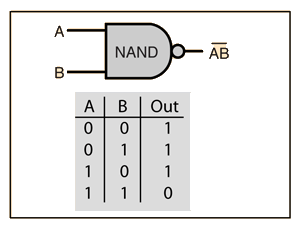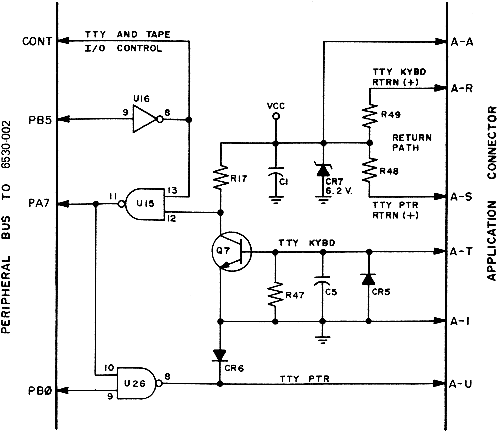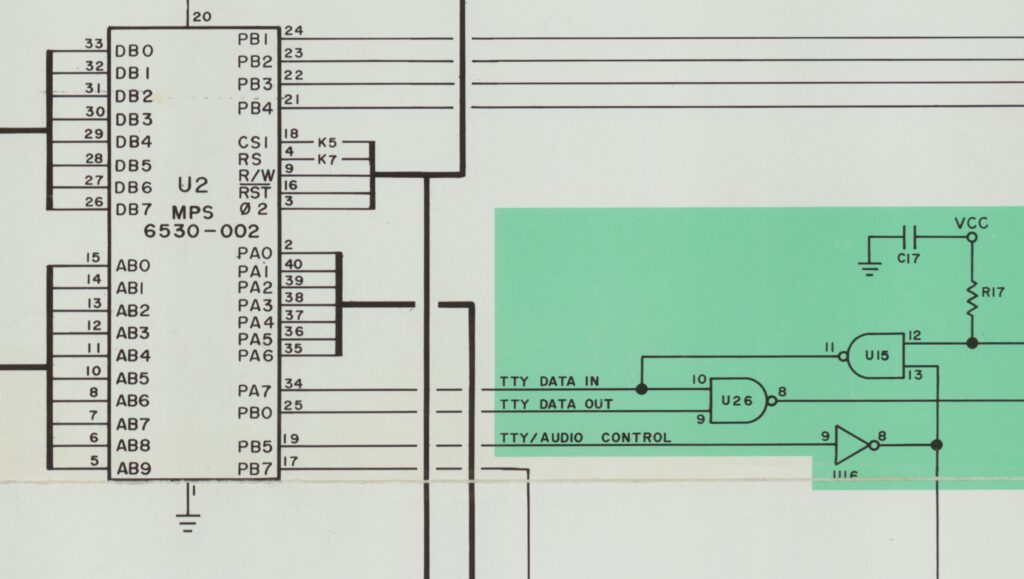Original article: KIM Kenner 17 page 14, Dutch, Hans Otten. Translation 2021 Hans Otten
Problem: the KIM-1 hardware is echoing incoming serial characters to the output, no echo in software involved. Very annoying!
In the KIM Kenner 1 Siep de Vries, founder of the Dutch KIM Club mentioned how in Focal for the 6502 a trick was built in to suppress the hardware echo by manipulating the TTY out bit. I examined later how it was done, from the Focal disassembly:
34AF E6 76 L34AF INC $76 ; random number? 34B1 2C 40 17 BIT H1740 ; check if character is incoming 34B4 30 F9 BMI H34AF ;=> wait until startbit 34B6 AD 42 17 LDA H1742 34B9 29 FE AND #$FE ; clear PA7 34BB 8D 42 17 STA H1742 34BE 20 5A 1E JSR H1E5A ; KIM-1 input 34C1 48 PHA 34C2 AD 42 17 LDA H1742 34C5 29 FE AND #$FE ; isolate PA7 34C7 09 01 ORA #$01 ; set PA7 to 1 34C9 8D 42 17 STA H1742 34CC 68 PLA 34CD 18 CLC 34CE 60 RTS
Hardware echo
I took the idea and implemented the software (without knowing then in 1980 the Focal disassembly!).
The echo of incoming serial to outgoing is shown in the next figures (from the KIM user manual and the KIM Circuit poster).
The TTY KEYBD signal goes via a transistor and NAND gate U15 to PA7 port of the 6532. That signal also goes to pin 10 input of NAND gate U26 which is the TTY out line. This is the hardware echo. When the KIM-1 sends out a character it comes from PB0 to pin 9 of of NAND gate U26 and so comes out to the TTY Out line.
Note that PB5 is connected via an inverter to NAND gate U15. The other input is TTY IN. Making PB5 high will make the TTY input PA7 deaf.
Note PB5 is also Audio out.
Suppress echo in software

The solution to suppress the echo is making output PB0 low. The NAND gate out will now stay high, ignoring any changes on the other input, which is the incoming serial character.
Only when receiving a character PBO should be made high. Also any incoming character will now not be echoed unless the program wants to receive a character!
Example program
In this routine the standard KIM-1 GETCH routine at $1E5A is encapsulated in a subroutine that prevents the echo by setting PB0. Note that this is not a complete block of the echo, it is only active when the program calls the blocking EGETCHAR. When the program sends out charactersto a dispaly, anything typed at the keyboard will also appear at the display.
The calling program is now responsible for the echoing!
0001 1000 echo .org $1000 0002 1000 ; 0003 1000 echoflag = $17E2 ; flag: 0 normal echo 0004 1000 SBD = $1742 ; KIM 6532 PIA B data register 0005 1000 GETCH = $1E5A ; KIM TTY Getch routine 0006 1000 ; 0007 1000 AD E2 17 EGETCHAR LDA echoflag ; if notechoflag 0008 1003 F0 08 beq normal ; then normal echo 0009 1005 AD 42 17 LDA SBD ; else set TTY bit PB0 to 0 0010 1008 29 FE AND #$FE 0011 100A 8D 42 17 STA SBD ; 0012 100D 20 5A 1E normal JSR GETCH ; get character from input 0013 1010 48 PHA ; save 0014 1011 AD 42 17 LDA SBD ; set TTY bit PB0 0015 1014 09 01 ORA #$01 0016 1016 8D 42 17 STA SBD 0017 1019 68 PLA ; restore received character 0018 101A 60 RTS 0019 101B .end 0020 101B tasm: Number of errors = 0
Does EGETCHAR work on the KIM-1 clones or SImulator?
Micro-KIM and PAL-1: yes, the hardware is identical, IC numbers are different
Corsham Technology: yes, though the hardware for audio is not there, there is still a NAND gate IC17C coupling PA7 and PB0.
KIM-1 Simulator V1.16 and higher: yes.
Enhanced solution: always deaf for input
If you study the hardware shown above you see PB5 also blocks the echo. The following routine tries to use this to make the input permanent deaf.
0001 1000 echo .org $1000 0002 1000 ; 0003 1000 echoflag = $17E2 ; flag: 0 normal echo 0004 1000 SBD = $1742 ; KIM 6532 PIA B data register 0005 1000 GETCH = $1E5A ; KIM TTY Getch routine 0006 1000 ; 0007 1000 ; no echo when reading character 0008 1000 ; 0009 1000 AD E2 17 EGETCHAR LDA echoflag ; if not echoflag 0010 1003 F0 08 beq normal ; then normal echo 0011 1005 AD 42 17 LDA SBD ; else set TTY bit PB0 to 0012 1008 29 FE AND #$FE 0013 100A 8D 42 17 STA SBD ; 0014 100D 20 5A 1E normal JSR GETCH ; get character form input 0015 1010 48 PHA ; save 0016 1011 AD 42 17 LDA SBD ; set TTY bit PB0 0017 1014 09 01 ORA #$01 0018 1016 8D 42 17 STA SBD 0019 1019 68 PLA ; restore received character 0020 101A 60 RTS 0021 101B ; 0022 101B ; no echo only at wish if reading character 0023 101B ; note that using tape I/O will leave PB5 low 0024 101B ; 0025 101B AD E2 17 DGETCHAR LDA echoflag ; if notechoflag 0026 101E F0 05 beq dnormal ; then normal echo 0027 1020 AD 42 17 LDA SBD ; else set TTY bit PB0 to 0028 1023 29 FE AND #$FE ; PB0 low 0029 1025 29 DF dnormal AND #$DF ; PB5 low 0030 1027 8D 42 17 STA SBD ; 0031 102A 20 5A 1E JSR GETCH ; get character from input 0032 102D 48 PHA ; save 0033 102E AD 42 17 LDA SBD ; set TTY bit PB0 and PB5 0034 1031 09 21 ORA #$21 ; high 0035 1033 8D 42 17 STA SBD 0036 1036 68 PLA ; restore received character 0037 1037 60 RTS 0038 1038 .end 0039 1038 0040 1038 tasm: Number of errors = 0
Note that using tape I/O will leave PB5 low, allowing echo, only set high when the program calls DGETCHAR.
Does DGETCHAR work on the KIM-1 clones?
Micro-KIM and PAL-1: yes, the hardware is identical, IC numbers are different
Corsham Technology: no, PB5 is not used.
KIM-1 Simulator: not yet


